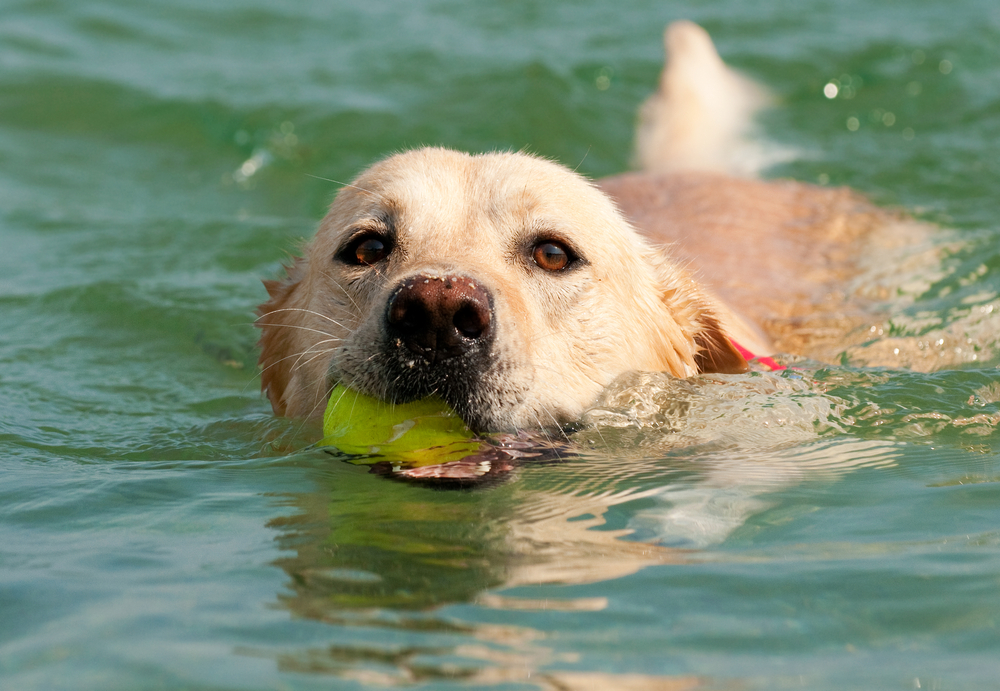Before our litter of Labrador retriever puppies went to their new homes, they learned to swim. Some would live at lake homes, others on the beach, and one went to canoe enthusiasts, so it was important to teach them not to be afraid of water. Even if your dog is an adult or senior or isn’t a traditional water dog, he can learn to be comfortable at the shore, lake, or pool.
Start on Dry Land
We started our puppies at six weeks old with games of fetch in the grass. Once each was excited by a toy, we added a kiddie pool. The incentive to get the toy, even if it bobbed in an inch or two of water, made the pool part of a grand game. They bounced and hopped in and out, and grabbed a puppy-sized rope or rubber bumper. We also turned on a sprinkler so the pups felt water splashing on their muzzles and around their eyes.
In the Swim
Introductions to the “big pool” were easy after that. They learned to pick up their feet and put them back down on a splash ledge where the water is four inches deep, and we put each on a raft so they all got the feel of water buoyancy. One at a time, each was carried into deeper water and and held while learning to move their feet in water.
Close supervision at this stage is critical; for safety, the people-to-pup ratio was 1:1. If any puppy startled, we backed up and let her splash in the kiddie pool until she showed curiosity in her littermates’ activity.
While not proficient swimmers when they left here, they were at least comfortable in the water. Our keeper puppy, Teaser, went on to earn a Dock Junior title at a year old, because she wanted that bobbing bumper she had chased in the weaning pen.
New Tricks for Older Dogs
Swim training isn’t just for puppies. Our oldest dog, Story, didn’t swim until she was eight, because we didn’t have access to water. When dock diving became more popular and facilities opened in our area, we took the dogs to try it. Story was fitted in a canine flotation vest, and the instructor backed her down a ramp into the pool. She was not fond of the dock, but will jump in the pool and paddle her now-13-year-old self around for a lap or two. Swimming is a major component of her mobility exercises.
Notice that Story wore a life vest and was backed into the water: our swim instructor insisted on this until each dog in the class proved their abilities. Some dogs will always need a life vest. Others, like Story, will ditch the vest before the first lesson is over. Until you know your dog can use all four legs underwater just as he does on the ground, consider a vest a life saver.
Confidence Builders
Dogs who are unfamiliar with or afraid of water might not startle if they are backed into water by a patient and gentle instructor. Start by teaching your dog to back up on land. Hallways are great training areas for this skill. Repeat the lesson on a shoreline or ramp into a pool. Always allow the dog to choose to participate or not.
Always end a swim lesson like any other training session, on a good note. Your dog might only want to get his feet wet. That’s okay. Next time he might wade up to his hocks.
A confident swimming dog can help a more hesitant dog, because dogs can learn by watching what other dogs do around them. Group classes are small and fun, and you will get tips from other owners and from the instructor. At the end of each of Story’s weekly swim sessions, all four dogs in the class were allowed in the pool to free swim for a few minutes.
Tips
If you plan to swim your dog in a lake, river, or ocean, keep in mind some safety considerations. Check local health department warnings about toxic algae or high levels of E. coli bacteria. Make sure river currents are not running too swiftly from dam releases upstream or that deadly ocean rip tides are not in your planned swimming area. In lakes, know locations of submerged stumps, fallen trees, boulders, or any obstruction that you cannot see from above. Boaters, always have a canine-specific flotation device on board, preferably on the dog.
Never toss a dog off the side of a boat or pool and expect him to swim back. Your dog could drown.
Don’t have a pool or easy access to a swimmable body of water? Check Sniffspot.com, where people with yards, pools, and acreages list play areas for hourly rental. You won’t encounter other dogs there unless you’ve organized your own swim group with known dogs.
Most important: good swimmers aren’t born. Like any skill in any canine sport, swimming is learned, and the benefits last a dog’s lifetime.
This article was reviewed/edited by board-certified veterinary behaviorist Dr. Kenneth Martin and/or veterinary technician specialist in behavior Debbie Martin, LVT.








